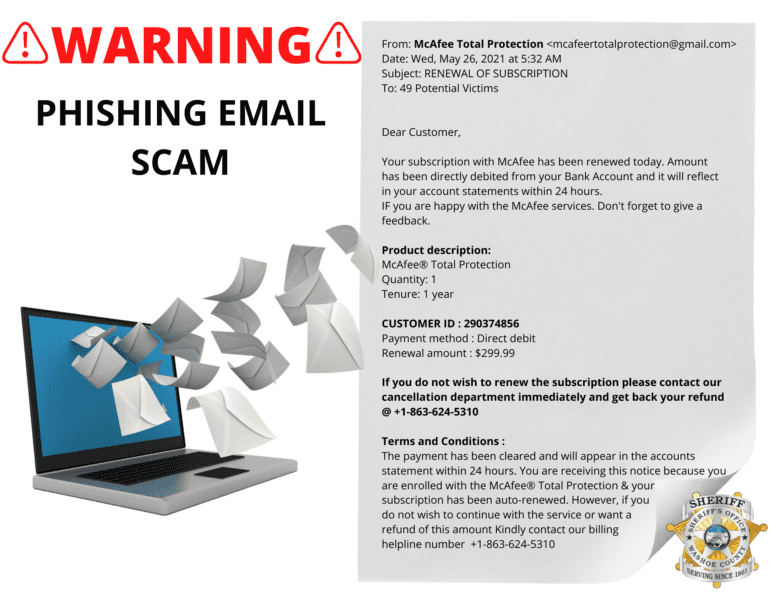
In an age where our digital lives are intertwined with almost every aspect of our daily routine, the threat of phishing scams has become more prevalent than ever before. Cybercriminals continuously devise new methods to trick unsuspecting users into divulging sensitive information, and one of the most concerning threats is known as McAfee phishing. This type of scam targets individuals who trust the McAfee brand, leveraging its reputation to manipulate victims into disclosing personal data or downloading malicious software. McAfee, a well-known cybersecurity company, aims to protect users from these threats, but even the most vigilant user can fall victim to these deceptive practices. Understanding the nature of McAfee phishing is crucial for safeguarding your online presence and ensuring that your information remains secure.
McAfee phishing scams can take various forms, including fraudulent emails, fake websites, and deceptive advertisements. These scams often use official-looking logos and language to create a sense of legitimacy, making it difficult for users to discern the difference between a genuine communication and a phishing attempt. As cybercriminals become increasingly sophisticated, it is essential for individuals to stay informed about the latest tactics used in McAfee phishing scams to avoid falling victim.
By recognizing the signs of McAfee phishing and knowing how to respond to potential threats, users can better protect themselves against these malicious attacks. This article will explore the various aspects of McAfee phishing, including how to identify these scams, preventative measures, and steps to take if you become a victim.
What is McAfee Phishing?
McAfee phishing refers to various online scams that impersonate the McAfee brand to deceive users into sharing sensitive information. Cybercriminals often create fake emails or websites that appear to be affiliated with McAfee, encouraging users to click on links or enter personal details. These scams exploit the trust that individuals have in the McAfee name, making it easier for scammers to execute their malicious plans.
How Do McAfee Phishing Scams Work?
McAfee phishing scams typically operate through the following methods:
- Deceptive Emails: Scammers send emails that appear to come from McAfee, often containing alarming messages about account issues or security threats. The emails usually include links that lead to counterfeit websites.
- Fake Websites: Cybercriminals create websites that closely mimic the official McAfee site, tricking users into entering their login credentials or payment information.
- Malicious Attachments: Some phishing emails may contain attachments that, when opened, install malware on the user's device.
Why Are McAfee Phishing Scams So Effective?
The effectiveness of McAfee phishing scams can be attributed to several factors:
- Brand Recognition: McAfee is a well-established cybersecurity company, and many users trust its products and services.
- Urgency and Fear Tactics: Phishing emails often create a sense of urgency, compelling users to act quickly without carefully evaluating the situation.
- Advanced Techniques: Scammers continuously adapt their tactics to evade detection, using social engineering methods to gain the victim's trust.
How Can You Identify McAfee Phishing Attempts?
Identifying McAfee phishing attempts requires vigilance and an understanding of common warning signs. Here are some key indicators to watch for:
- Unusual Sender Addresses: Check the email address of the sender. Phishing emails often come from addresses that resemble legitimate ones but contain slight variations.
- Generic Greetings: Legitimate communications from McAfee typically use personalized greetings. Phishing emails often use generic terms such as "Dear Customer."
- Suspicious Links: Hover over links to see the actual URL before clicking. If the link does not lead to the official McAfee website, it may be a phishing attempt.
What Should You Do If You Encounter McAfee Phishing?
If you suspect that you've encountered a McAfee phishing attempt, follow these steps:
Can McAfee Protect You from Phishing Scams?
Yes, McAfee offers various tools and features designed to protect users from phishing scams. These include:
- Web Protection: McAfee's web protection tools can warn users about potentially dangerous websites and block access to them.
- Email Scanning: McAfee scans incoming emails for known phishing threats and blocks malicious attachments.
- Real-Time Threat Detection: McAfee continuously updates its threat database to recognize and defend against evolving phishing tactics.
What Are the Consequences of Falling for McAfee Phishing?
Falling victim to McAfee phishing can have serious repercussions, including:
- Identity Theft: Cybercriminals may use stolen personal information to commit fraud or open accounts in your name.
- Financial Loss: Victims may face unauthorized charges on their accounts or loss of savings.
- Device Compromise: Malware installed through phishing attempts can lead to data breaches and exploitation of personal information.
How Can You Stay Safe from McAfee Phishing?
To protect yourself from McAfee phishing, consider the following tips:
- Educate Yourself: Stay informed about the latest phishing tactics and scams.
- Use Strong Passwords: Create unique, strong passwords for your accounts and change them regularly.
- Enable Two-Factor Authentication: Whenever possible, enable two-factor authentication for added security.
Conclusion: Staying Vigilant Against McAfee Phishing
As cyber threats continue to evolve, understanding McAfee phishing is essential for protecting your personal information. By recognizing the signs of phishing attempts, knowing how to respond, and utilizing the security measures provided by McAfee, you can significantly reduce your risk of falling victim to these scams. Remember, staying informed and vigilant is your best line of defense against phishing attacks.
ncG1vNJzZmivp6x7p7XGoaugqpGlva2x05qnZ5ufony4w9agqaKcYWS6pK3FnpxmqJiewKm1zaBloaydoQ%3D%3D